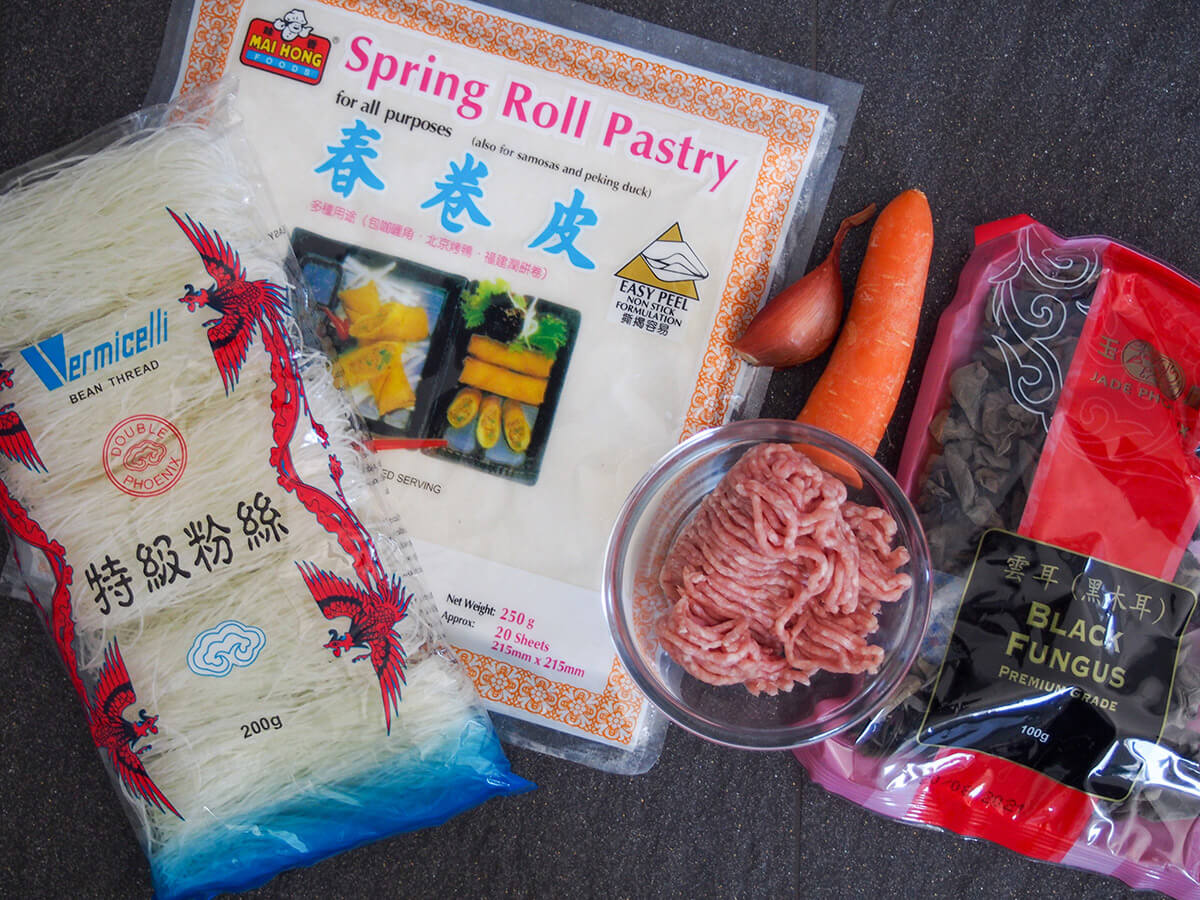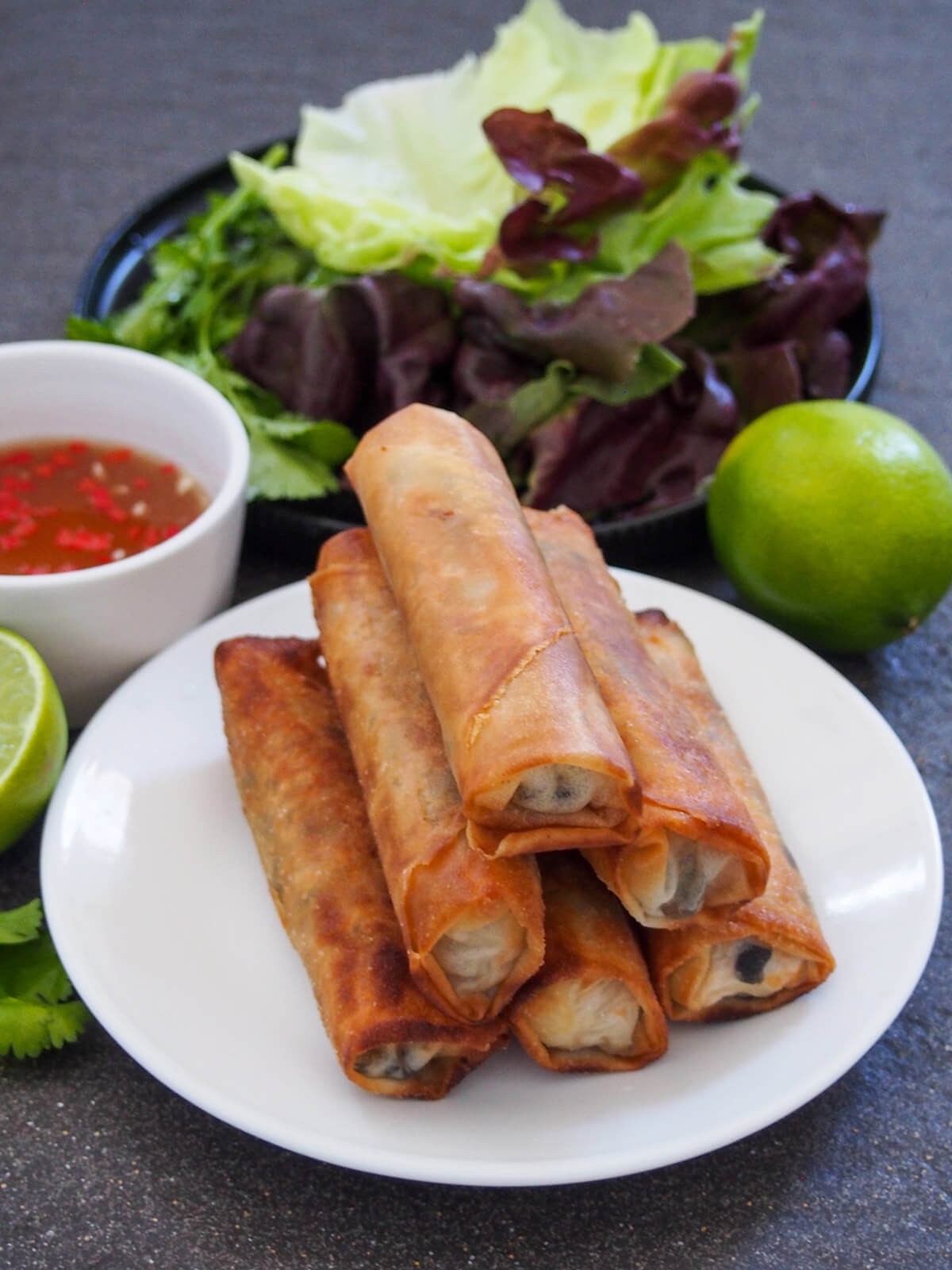Vietnamese fried spring rolls (cha gio) have a delicious mix of crisp outside and tasty filling which includes noodles and pork. They make a great appetizer dipped in light nuoc cham sauce or added to other dishes.

This post may contain affiliate links, where we earn from qualifying purchases. See more details in the policy page.
One of the definite upsides of our time in Melbourne was having restaurants from lots of different cuisines within relatively easy reach. I've found that my kids are somehow often more open to trying new foods in a restaurant than at home. So it has helped me introduce some new things (as well as enjoy different foods myself).
Vietnamese food has always been one of my favorites, and it was great having a few places that had a range of different dishes to enjoy, as well as Vietnamese friends who could give us tips. Both soft and crisp spring rolls were a popular choice in our household, and understandably so.

Different types of spring rolls
When you think of spring rolls, these are probably not the first thing you think of. You probably either think of the crispy Chinese spring rolls or soft Vietnamese rolls. Each is that little bit different.
Chinese spring rolls, chūn juǎn, are made with thin wheat wrappers and are usually filled with cabbage and often bean sprouts or bamboo shoots and sometimes pork. You'll often use oyster sauce as part of the seasoning, though the fillings and seasonings vary regionally as well. You fry them so they are crisp on the outside.
Soft Vietnamese spring rolls, goi cuon, have rice wrappers that are softened in water rather than cooked. Fillings can vary, but the more traditional fillings include rice noodles, lettuce and herbs, shrimp and/or pork.
You might also know them as summer rolls, and these days you'll also find less traditional fillings like duck and mixed vegetable. In all cases, they are served chilled.

These crispy Vietnamese spring rolls, chả giò or nem rán (N Vietnam), are traditionally also made with rice paper wrappers but these days thin wheat wrappers are becoming more common. The wheat wrappers tend to crisp up better and have less issues with them cracking and the filling escaping. You also don't need to pre-soak them.
The filling is typically broken up mung bean vermicelli noodles and mushrooms, (often wood ear) along with pork and, sometimes, shrimp, though this can vary regionally. You often have other vegetables in there as well.
They're fried to be nice and crisp, but you can bake if you prefer (it's less traditional and they are typically less crisp). You might also see these called Vietnamese egg rolls.
You'll also find variations on the theme in Malaysia, Indonesia, Singapore and the Philippines.

Tips for making these
These are not that difficult to make, but do have a couple steps and it's worth keeping a couple things in mind. First, get all of your filling prepared before you open your spring roll wrappers to save the wrappers drying out. Try to chop the mushrooms pretty small to make them easier to eat.
Don't overfill the rolls - they take less than you might think! Keep them as even as possible to help them all cook at the same speed. If possible, roll relatively quickly so they don't dry out. Use the description and photos above to help in how to fold them.
It can be tempting to try to limit oil, but it actually just means they are more likely to burn or not cook evenly rather than take on any less. So make sure you have a layer in your wok or skillet at all times.

How to serve chả giò
The most typical way to eat these is wrapped in a lettuce leaf, often with a few herbs in there as well like mint or cilantro, and then dipped in nuoc cham (correctly written as nước chấm).
Nước chấm is in some ways a range of sauces served with many Vietnamese dishes, like bun cha Hanoi, sugar cane shrimp and with grilled meats. The ingredients vary, depending what its paired with, but it's typically a sweet, sour, salty and sometimes spicy mix. Fish sauce is in most, with lime and sugar also in many versions.
These rolls are often more of a snack food that you might have between meals. Being finger food, they are perfect to pick up at a street stall. They are also sometimes a component of other dishes such as bun thit nuong (a dish of noodles, pork and shrimp) and salads.
A common part of Vietnamese meals is having a range of dishes that are shared between the table. Sometimes this more a main with some sides, but can extend to a much broader range of dishes for feasts. Chả giò are a dish you'll pretty much always find as part of the feast for Tết Nguyên Đán, the Vietnamese Lunar New Year.

Whether as part of a feast, as an appetizer or snack, there's no doubt these Vietnamese fried spring rolls are a delicious savory treat. The fillings are relatively simple but a tasty mix, and the nuoc cham dipping sauce is the perfect pairing. So get rolling, and try them soon.
Try these other finger food appetizers:
- Tiropita (Greek cheese pastries)
- Chicken yakitori
- Chorizo cheese twists
- Pan con tomate (Spanish tomato bread)
- Plus get more appetizer recipes and Southeast Asian recipes in the archives.
Vietnamese fried spring rolls - cha gio
Ingredients
For spring rolls
- ¼ cup dried wood ear mushroom (¼ cup is around ½ oz)
- 1 oz dried vermicelli noodles traditionally mung bean, can be rice - also called cellophane noodles
- 2 shallots
- 1 carrot
- ½ lb ground pork
- ½ teaspoon salt
- ½ teaspoon pepper
- ½ teaspoon sugar
- 12 spring roll wrappers (see notes)
To cook
- ½ cup soybean oil or canola oil, or more as needed
For nuoc cham
- ½ red chili small, or more/less to taste
- ½ clove garlic
- 2 tablespoon water
- 1 ½ tablespoon lime juice
- 1 tablespoon fish sauce
- ½ tablespoon sugar
- ⅛ teaspoon salt
To serve
- butter or red lettuce leave, herbs such as cilantro, Vietnamese mint and/or perilla
Instructions
For spring rolls
- Place the wood ear mushrooms and vermicelli noodles in small bowls and cover both with hot water. Leave each to sit until the mushrooms expand and the noodles become white, around 5-10 minutes for each. Drain both and chop the mushrooms finely and the noodles into small lengths.
- As the mushrooms and noodles are soaking, finely chop the shallots and peel and grate the carrot.
- Mix together the ground pork, mushrooms, noodles, shallots, carrot, salt, pepper and sugar. Use your hands if necessary to mix well (they may not all completely stick together but that's fine). Divide the mixture into 12 relatively equal pieces.
- Lay one spring roll wrapper on a clean surface with a corner pointing towards you. Have a small bowl of water ready next to you. Fold over the nearest corner of the wrapper inwards to almost the middle of the wrapper and then put one portion of the filling on top in a small log cross-wise near the folded edge.
- Fold in both sides to just be covering the end of the log and so the folds formed are parallel with each other. Fold the first folded edge over the filling, making sure the sides stay folded in to avoid the filling from escaping, and keep rolling up until only a triangle is left. Try to avoid having much air inside as you roll.
- Dampen the tip of your finger and moisten the edges of the remaining triangle of the wrapper then keep rolling so that the end of the wrapper sticks flat onto the roll. Repeat with the rest of the wrappers and filling.
- Warm the oil in a skillet over a medium-high heat (you can either do a few in a smaller skillet at a time and cook more in a larger skillet - it will be quicker more at a time but probably easier to turn before they cook too much if cooking smaller batches). Add the rolls to the oil and cook for around 2-3 minutes on each side until they are golden all over. Remove from the skillet and drain on kitchen paper. Repeat to cook the rest of the rolls, topping up the oil as needed.
For nuoc cham
- Finely chop the chili and garlic. Combine all ingredients (water, lime, fish sauce, chili, garlic, sugar and salt) and stir so that the sugar dissolves. Use as a dipping sauce for the spring rolls - traditionally you wrap a roll in a lettuce leaf, along with a couple stems of herbs, before dipping.
Video
Notes
Nutrition
See some of my favorite cooking tools and ingredients in the Caroline's Cooking Amazon store.
I have drawn on various recipes in making these, particularly this Hungry Huy recipe and this Vicky Pham recipe.
I first shared the post for cha gio on Curious Cuisiniere where I am a contributor.
Remember to pin for later!




Ronni says
Can these be made ahead and fried the next day?
Caroline's Cooking says
I'd be a little worried about the wrappers becoming either a bit too dry if not properly covered, or becoming damp with the moisture from in the fridge that would impact the texture. It may work, but you'd want to make sure you watch for that.
Steven says
Do we need to precook or parcook the pork before we put it in the mix?
Caroline's Cooking says
No, since these are relatively thin the pork cooks as you cook them - just make sure you have enough oil so there is a layer of oil and that they cook until golden.
Emily Flint says
These spring rolls are so good and I had no idea how easy they were to make at home. We are never ordering out for these again!
Caroline's Cooking says
Glad to hear they worked out well for you!
Shadi says
This is absolutely delicious! I love that it’s such a crowd pleaser for the whole family.
Caroline's Cooking says
Thanks, and yes it goes down well here too.